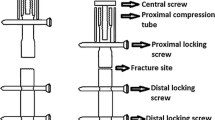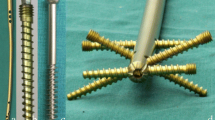Abstract
Background
Modern intramedullary implants provide the option to perform compression at the fracture gap in long bone fractures via a compression screw mechanism. The aim of this study was to assess if the application of interfragmentary compression in the intramedullary nailing of tibia fractures could increase the union rate and speed of fracture healing.
Methods
Sixty-three patients who suffered from an AO-type 42-A3 or 42-B2 fracture that was treated by reamed intramedullary nailing between 2003 and 2008 were included in this retrospective study. Twenty-five patients were treated with dynamic interlocking without compression while 38 were treated with compression nailing. The compression load of the dynamic proximal screw was calculated by postoperative X-ray and radiographs taken four weeks after operation. Healing was assessed by radiological evaluation until the completion of bony healing or the disappearance of clinical symptoms. Nonunion was defined as the absence of radiological union and the persistence of clinical symptoms after six months.
Results
Postoperative compression was applied at a mean load of 1,852 N, and 980 N remained after four weeks. In the compression group, 19 open and 19 closed fractures occurred. In the non-compression group, 25 patients were included (14 closed and 11 open cases). Active compression decreased healing time significantly. Nonunion occurred in one compression patient and three non-compression patients.
Conclusion
The results show that additional compression of the fracture gap can improve healing outcome in simple transverse tibial shaft fractures treated with reamed nailing.



Similar content being viewed by others
References
Claes LE, Heigele CA. Magnitudes of local stress and strain along bony surfaces predict the course and type of fracture healing. J Biomech. 1999;32:255–66.
Claes LE, Heigele CA, Neidlinger-Wilke C, Kaspar D, Seidl W, Margevicius KJ, Augat P. Effects of mechanical factors on the fracture healing process. Clin Orthop Releat Res. 1998;355:S132–47.
Augat P, Simon U, Liedert A, Claes L. Mechanics and mechano-biology of fracture healing in normal and osteoporotic bone. Osteoporos Int. 2005;16(Suppl 2):36–43.
Bhandari M, Tornetta P, Sprague S, Najibi S, Petrisor B, Griffith L, Guyatt GH. Predictors of reoperation following operative management of fractures of the tibial shaft. J Orthop Trauma. 2003;17:353–61.
Gaebler C, Berger U, Schandelmaier P, Greitbauer M, Schauwecker HH, Applegate B, Zych G, Vecsei V. Rates and odd ratios for complications in closed and open tibial fractures treated with unreamed small diameter nails: a multicenter analysis of 467 cases. J Orthop Trauma. 2001;15:415–23.
Schandelmaier P, Kretteck C, Tscherne H. Biomechanical study of nine different tibia locking nails. J Orthop Trauma. 1996;10:37–44.
Augat P, Burger J, Schorlemmer S, Henke T, Peraus M, Claes L. Shear movement at the fracture site delays healing in a diaphyseal fracture model. J Orthop Res. 2003;21:1011–7.
Augat P, Penzkofer R, Nolte A, Maier M, Panzer S, v Oldenburg G, Püschel K, Simon U, Bühren V. Interfragmentary movement in diaphyseal tibia fractures fixed with locked intramedullary nails. J Orthop Trauma. 2008;22:30–6.
Penzkofer R, Maier M, Nolte A, vOldenburg G, Püschel K, Bühren V, Augat P. Influence of intramedullary nail diameter and locking mode on the stability of tibial shaft fracture fixation. Arch Orthop Trauma Surg. 2009;129:525–31.
Gonschorek O, Hofmann GO, Bühren V. Interlocking compression nailing: a report on 402 applications. Arch Orthop Trauma Surg. 1998;117:430–7.
Lacroix D, Prendergast PJ. Three-dimensional simulation of fracture repair in the human tibia. Comput Methods Biomech Biomed Engin. 2002;5(5):369–76.
Gardner MJ, van der Meulen MC, Demetrakopoulos D, Wright TM, Myers ER, Bostrom MP. In vivo cyclic axial compression affects bone healing in the mouse tibia. J Orthop Res. 2006;24(8):1679–86.
Wähnert D, Mückley T, Gerber C, v Oldenburg G, Steinhauser E, Bühren V. Compression force analysis for an intramedullary nailing system in humerus, tibia and femur. Biomaterialien. 2007;8(4):299–304.
Perren SM. Physical and biological effects of fracture healing with special reference to internal fixation. Clin Orthop Relat Res. 1979;138:175–96.
Gupta A. Dynamic compression nail: a preliminary report. BMC Musculoskelet Disord 2001;2:6.
Acknowledgments
We would like to thank Kevin Burfeind (a native English speaker from America) for his translational work. The compression force was calculated by Stryker Osteosynthesis. There was no financial sponsorship of this work from industry.
Author information
Authors and Affiliations
Corresponding author
Rights and permissions
About this article
Cite this article
Högel, F., Gerber, C., Bühren, V. et al. Reamed intramedullary nailing of diaphyseal tibial fractures: comparison of compression and non-compression nailing. Eur J Trauma Emerg Surg 39, 73–77 (2013). https://doi.org/10.1007/s00068-012-0237-3
Received:
Accepted:
Published:
Issue Date:
DOI: https://doi.org/10.1007/s00068-012-0237-3




